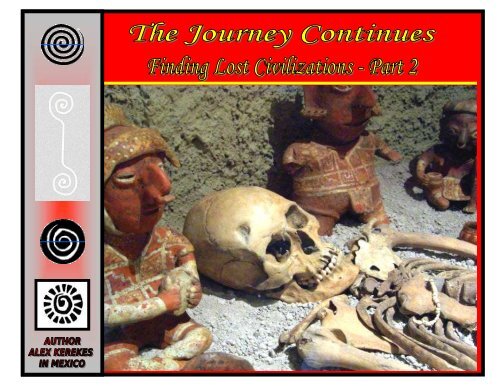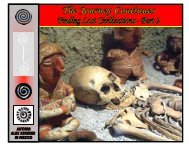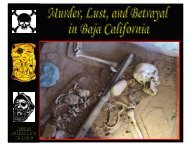The Journey Continues - Finding Lost Civilizations, Part 2.
The Journey Continues - Finding Lost Civilizations, Part 2.
The Journey Continues - Finding Lost Civilizations, Part 2.
You also want an ePaper? Increase the reach of your titles
YUMPU automatically turns print PDFs into web optimized ePapers that Google loves.
<strong>The</strong> <strong>Journey</strong> <strong>Continues</strong><br />
<strong>Finding</strong> <strong>Lost</strong> <strong>Civilizations</strong><br />
<strong>Part</strong> 2<br />
By<br />
Alexander Kerekes<br />
Published<br />
Carmel, California
<strong>The</strong> <strong>Journey</strong> <strong>Continues</strong> - <strong>Finding</strong> <strong>Lost</strong> <strong>Civilizations</strong><br />
<strong>Part</strong> 2<br />
Copyright © 2010 Alexander Kerekes<br />
www.storiesbyalex.com<br />
All rights reserved under International and Pan-American<br />
copyright conventions. No part of this book may be used<br />
or reproduced in any manner whatsoever without<br />
written permission except in the case of brief<br />
quotations embodied in critical articles or reviews.<br />
ISBN 978-1-9-935530-21-3<br />
Printed in the U.S.A. - First U.S. Edition August 2010<br />
Published by<br />
Alexander Kerekes<br />
Carmel, California<br />
Author’s Note: While trekking through the State of Nayarit, Mexico, my primary purpose was to discover petroglyphs and signs of<br />
ancient civilizations. Many of the artifacts illustrated in my books were shown to me by local natives who shared their stories.<br />
Surprisingly, many objects were observed still laying on the ground in areas where villages and life had once existed many years<br />
before. I did not conduct excavations of archaeological sites or tombs.
Preface<br />
Each time my father and I visited Mexico we had no plan or idea where our journey would<br />
take us. And each time we left we never made plans to return. We simply followed a path in<br />
our lives that revealed itself with each step we took forward. In 2008 I published <strong>Finding</strong> <strong>Lost</strong><br />
<strong>Civilizations</strong> and thought that was the end of my journey. But in 2009 and 2010 my father<br />
and I returned to Mexico and found ourselves on a road to discovery that we had never<br />
experienced before. We met many wonderful local people who shared stories, legends of<br />
ancient times, and lost treasures. I was often taken to locations where no one other than the<br />
original inhabitants had set foot. And even today I sometimes ask myself, “Did this really<br />
happen?” Many people have said, “Write another book.”<br />
Consequently, I decided to publish a sequel, <strong>The</strong> <strong>Journey</strong> <strong>Continues</strong> - <strong>Finding</strong> <strong>Lost</strong><br />
<strong>Civilizations</strong>, <strong>Part</strong> <strong>2.</strong> As with my first book, many people have asked me, “Is this story true?”<br />
“Did you actually find a treasure?” And so again I will say, “Yes, it is mostly true.” So, close<br />
your eyes and let your imagination illuminate a path behind my footsteps as I follow the<br />
thread of lost civilizations. And then judge for yourself. <strong>The</strong> journey continues.<br />
<strong>The</strong> journey continues.<br />
1
Chapters<br />
Preface.............................................................1<br />
<strong>The</strong> Forgotten Souls of Ixtapa de La<br />
Conception...................................................….5<br />
<strong>The</strong> Temple of San Ignacio........................….14<br />
Returning to San Pedro De Lagunillas...…....28<br />
Bandit Treasures ......................................….35<br />
<strong>The</strong> Truth……………………………………….…86<br />
Petroglyph Photo Log……………………………88<br />
<strong>The</strong> Tecolote…………………………………….102<br />
Tombs……………………………………….…...104<br />
<strong>The</strong> Old Gringo……….…………………………120<br />
Sacred Altars and Secret Caves………….…..126<br />
Maria’s Story................................................…48<br />
In Search of Manuel..............................……...52<br />
<strong>The</strong> Witching Moment................................…..54<br />
Secret Passages of Hacienda La<br />
Condesa….......................................................58<br />
My Mother and the Jaguar……………………71<br />
2
<strong>The</strong> <strong>Journey</strong> <strong>Continues</strong><br />
<strong>Finding</strong> <strong>Lost</strong> Civilization - <strong>Part</strong> 2<br />
<strong>The</strong>re are 32 States in<br />
Mexico. <strong>The</strong> <strong>Journey</strong><br />
takes place in the<br />
coastal State of Nayarit.<br />
State of Nayarit<br />
3
Pacific Ocean<br />
4
Chapter 1<br />
<strong>The</strong> Forgotten Souls of Ixtapa De<br />
La Conception<br />
While at the La Penita market a lady named<br />
Deb Drew approached me and said she was<br />
building a pool at her house. She invited my<br />
father and me to join her and her husband to<br />
sift through the dirt during the excavation. On<br />
the day of the excavation I spoke with the<br />
Mexican backhoe operator, who told me he had<br />
been driving a backhoe for more than 20 years<br />
and that his home garden held many remnants<br />
of old civilizations he had dug up during<br />
excavations. He said he did not believe we<br />
would find any ancient artifacts in La Penita. I<br />
then asked him which area contained the most<br />
relics. He thought for a while and said that the<br />
area most fertile and filled with ancient<br />
artifacts was in a small town called Ixtapa De<br />
La Conception. By chance, I had planned a trip<br />
the next day to the fishing village of Platanitos<br />
and would be passing through Ixtapa.<br />
<strong>The</strong> following day I drove to the village of<br />
Ixtapa. It had only one small, dusty main street,<br />
and as I entered I saw a man walking down the<br />
road. I introduced myself and explained that I<br />
was writing about the history of the region and<br />
asked him if he knew of any ancient Indian<br />
sites or symbols that were engraved into large<br />
boulders in the area. He said there were ancient<br />
sites and petroglyphs in the area, but he did not<br />
know their exact locations. However, he said<br />
he knew a man who did and volunteered to<br />
walk me to his house. I followed this man<br />
through town and we eventually arrived at a<br />
brick building that was painted yellow. I<br />
immediately felt that this person was certainly<br />
an artifact collector who was knowledgeable of<br />
the ancient sites in this area. Hanging over his<br />
doorway and across the front of the house were<br />
the skulls of very large rams—something like a<br />
5
medicine man would have over his hut or<br />
tepee. Unfortunately, the local historian was<br />
not home. But the helpful local man, Jose,<br />
agreed to let the historian, Donicia, know that I<br />
would return later in the day. My father and I<br />
and several friends then went to the fishing<br />
village of Platanitos to visit the lookout point<br />
from where we saw migrating whales. Later,<br />
we ate some wonderful shrimp and fish in a<br />
fisherman’s palapa by the ocean. It was a<br />
wonderful and special day.<br />
Platanitos Lookout Point<br />
6
On the way home I drove to Donicia’s house<br />
and saw several people sitting in the backyard.<br />
Two other men arrived later and I introduced<br />
myself. After explaining my interest in the<br />
archeology of the area, Donicia and his friend<br />
Manuel agreed to show me some ancient sites<br />
the following day. <strong>The</strong>y also volunteered to<br />
take me directly to a site a short distance away.<br />
I agreed and we drove to Manuel’s home, a<br />
small adobe and brick house behind the town<br />
cemetery.<br />
From there we followed an old path up a hill. I<br />
saw a large excavation to the left and learned<br />
that this was a very old mine the Spaniards had<br />
excavated hundreds of years before. <strong>The</strong><br />
tunnels, I was told, stretched for several<br />
kilometers and once yielded silver. We<br />
continued along the trail, traveling to the<br />
backside of the hill and then to an elevated<br />
pasture atop another hill. <strong>The</strong>re I immediately<br />
noticed a large boulder several hundred feet<br />
ahead that had some sort of petroglyph art.<br />
Walking toward the boulder, I came upon a<br />
tomb excavation and observed tomb markers<br />
strewn on the ground alongside a depression in<br />
the earth. Manuel told me someone had<br />
excavated the tomb to a depth of about one foot<br />
and then stopped. He pointed to another hill<br />
where he said many tomb markers were still<br />
standing vertically over ancient graves. This<br />
was exciting; I had seen many such tomb<br />
markers but most were lying on the ground,<br />
having been either knocked down or moved<br />
from their original location.<br />
7
I then walked to the petroglyph boulder and immediately noticed a cat-like figure pecked into the<br />
stone; Manuel referred to this as a coyote. <strong>The</strong>re was another animal next to it, but I could not<br />
discern what it was.<br />
8
Adjacent to the coyote boulder was another boulder that had interconnecting Spirals and the outline<br />
of a person resembling an alien!<br />
9
<strong>The</strong>se two different petroglyph designs were<br />
produced using separate styles. <strong>The</strong> cat-like<br />
figure was pecked into the boulder, whereas the<br />
Spirals and alien were etched into the stone.<br />
Continuing to survey the pasture, I saw many<br />
pieces of pottery and obsidian on the ground. I<br />
also saw several other tombs and one large<br />
boulder that had a large Spiral.<br />
<strong>The</strong> east side of the pasture was the backside of<br />
the hill. Manuel told me that many tomb<br />
markers in that area were lying on the ground,<br />
but they belonged to French soldiers. I found<br />
this very exciting because there indeed had<br />
been a period in Mexico’s history when the<br />
French invaded Mexico and installed an<br />
emperor. He was referred to as Maximilian I,<br />
Emperor of Mexico. He was born Ferdinand<br />
Maximilian Joseph and was a member of<br />
Austria’s Imperial Habsburg-Lorraine family.<br />
With the backing of Napoleon III of France and<br />
a group of Mexican monarchists, he was<br />
proclaimed Emperor of Mexico. His reign did<br />
not last and in 1867 he was captured and<br />
executed by the Mexican forces of Benito<br />
Juarez.<br />
<strong>The</strong> thought of French Foreign Legionnaires<br />
buried in the vicinity of this long-forgotten hill<br />
was intriguing. While climbing down the hill<br />
towards the French graves I saw a reflection<br />
and walked over to see what it was.<br />
10
To my utter surprise I saw the handle of a small<br />
sword. I scraped away the dirt and Mother<br />
Earth opened her treasures to me. I had found<br />
an old military sword! Was it one of the items<br />
buried with a French Foreign Legionnaire? Did<br />
he die fighting with his last breath, sword in<br />
hand, for a glory that means nothing today?<br />
Who was he, what was his name? I resolved to<br />
return to that spot and give homage to these<br />
lost souls buried on this lonely hill and<br />
forgotten in time.<br />
Later, as we walked off the hill we met another<br />
fellow along the trail; this man mentioned that<br />
the grave markers were actually German. This I<br />
found interesting because when Maximilian<br />
was defeated, his Imperial Army also had<br />
several legions of Austrian and Belgian<br />
volunteers.<br />
As we walked back to Manuel’s house he<br />
pointed out a rise in the distance toward the<br />
ocean and said there was a pyramid on the top<br />
of that hill, which he called San Ignacio. As I<br />
gazed at the hill the crest did appear to be<br />
pyramid-shaped and we both agreed that we<br />
would explore it someday.<br />
Manuel later invited me into his backyard,<br />
where he pointed out many artifacts that were<br />
laid out on a concrete platform. Everything had<br />
been found in the hills and pasture we had just<br />
explored. <strong>The</strong>re was an ancient stone head to a<br />
battle-ax, a stone ax, various corn-grinding<br />
11
platforms and stone grinders, several small clay<br />
heads from ancient figures, and many other<br />
implements whose use I could not identify.<br />
Manuel’s Treasures<br />
War Club – Battle-Ax<br />
Returning home to Los Ayala I swam in the<br />
ocean and watched the sunset from the water. I<br />
then floated on my back and saw the half-moon<br />
appear behind a red and blue horizon. Closing<br />
my eyes, I floated into the inner reaches of my<br />
mind, suspended in time, space, and water. It<br />
was truly a wonderful day of discovery.<br />
12
After our explorations my father and I always returned for a refreshing<br />
swim in the ocean and to Nayarit Sunsets<br />
13







